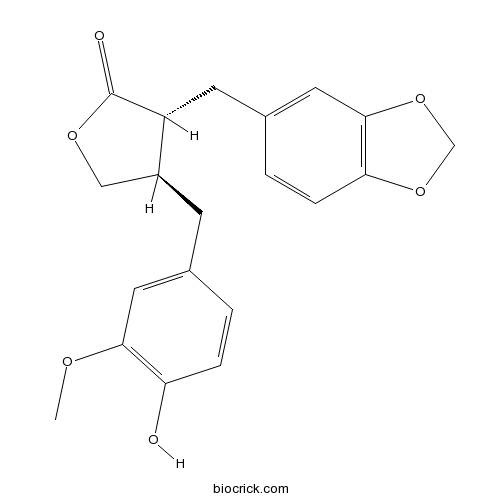(-)-HaplomyrfolinCAS# 85404-48-4 |

Quality Control & MSDS
3D structure
Package In Stock
Number of papers citing our products

| Cas No. | 85404-48-4 | SDF | Download SDF |
| PubChem ID | 101995247 | Appearance | Powder |
| Formula | C20H20O6 | M.Wt | 356.4 |
| Type of Compound | Lignans | Storage | Desiccate at -20°C |
| Solubility | Soluble in Chloroform,Dichloromethane,Ethyl Acetate,DMSO,Acetone,etc. | ||
| Chemical Name | (3R,4R)-3-(1,3-benzodioxol-5-ylmethyl)-4-[(4-hydroxy-3-methoxyphenyl)methyl]oxolan-2-one | ||
| SMILES | COC1=C(C=CC(=C1)CC2COC(=O)C2CC3=CC4=C(C=C3)OCO4)O | ||
| Standard InChIKey | NFAAULYTGYCSKM-LSDHHAIUSA-N | ||
| Standard InChI | InChI=1S/C20H20O6/c1-23-18-8-12(2-4-16(18)21)6-14-10-24-20(22)15(14)7-13-3-5-17-19(9-13)26-11-25-17/h2-5,8-9,14-15,21H,6-7,10-11H2,1H3/t14-,15+/m0/s1 | ||
| General tips | For obtaining a higher solubility , please warm the tube at 37 ℃ and shake it in the ultrasonic bath for a while.Stock solution can be stored below -20℃ for several months. We recommend that you prepare and use the solution on the same day. However, if the test schedule requires, the stock solutions can be prepared in advance, and the stock solution must be sealed and stored below -20℃. In general, the stock solution can be kept for several months. Before use, we recommend that you leave the vial at room temperature for at least an hour before opening it. |
||
| About Packaging | 1. The packaging of the product may be reversed during transportation, cause the high purity compounds to adhere to the neck or cap of the vial.Take the vail out of its packaging and shake gently until the compounds fall to the bottom of the vial. 2. For liquid products, please centrifuge at 500xg to gather the liquid to the bottom of the vial. 3. Try to avoid loss or contamination during the experiment. |
||
| Shipping Condition | Packaging according to customer requirements(5mg, 10mg, 20mg and more). Ship via FedEx, DHL, UPS, EMS or other couriers with RT, or blue ice upon request. | ||
| Description | (-)-Haplomyrfolin is a natural product from Platycladus orientalis. |
| Structure Identification | Phytochemistry, 1996 , 42 (3) :695-699.Lignans, alkaloids and coumarins from Haplophyllum vulcanicum ☆[Reference: WebLink]
|

(-)-Haplomyrfolin Dilution Calculator

(-)-Haplomyrfolin Molarity Calculator
| 1 mg | 5 mg | 10 mg | 20 mg | 25 mg | |
| 1 mM | 2.8058 mL | 14.0292 mL | 28.0584 mL | 56.1167 mL | 70.1459 mL |
| 5 mM | 0.5612 mL | 2.8058 mL | 5.6117 mL | 11.2233 mL | 14.0292 mL |
| 10 mM | 0.2806 mL | 1.4029 mL | 2.8058 mL | 5.6117 mL | 7.0146 mL |
| 50 mM | 0.0561 mL | 0.2806 mL | 0.5612 mL | 1.1223 mL | 1.4029 mL |
| 100 mM | 0.0281 mL | 0.1403 mL | 0.2806 mL | 0.5612 mL | 0.7015 mL |
| * Note: If you are in the process of experiment, it's necessary to make the dilution ratios of the samples. The dilution data above is only for reference. Normally, it's can get a better solubility within lower of Concentrations. | |||||

Calcutta University

University of Minnesota

University of Maryland School of Medicine

University of Illinois at Chicago

The Ohio State University

University of Zurich

Harvard University

Colorado State University

Auburn University

Yale University

Worcester Polytechnic Institute

Washington State University

Stanford University

University of Leipzig

Universidade da Beira Interior

The Institute of Cancer Research

Heidelberg University

University of Amsterdam

University of Auckland

TsingHua University

The University of Michigan

Miami University

DRURY University

Jilin University

Fudan University

Wuhan University

Sun Yat-sen University

Universite de Paris

Deemed University

Auckland University

The University of Tokyo

Korea University
- Norcaesalpinin E
Catalog No.:BCN7006
CAS No.:854038-96-3
- Dasatinib hydrochloride
Catalog No.:BCC1517
CAS No.:854001-07-3
- OGT 2115
Catalog No.:BCC7458
CAS No.:853929-59-6
- NVP-BAG956
Catalog No.:BCC1813
CAS No.:853910-02-8
- (+)-AJ 76 hydrochloride
Catalog No.:BCC6747
CAS No.:85378-82-1
- SKF 89976A hydrochloride
Catalog No.:BCC6930
CAS No.:85375-15-1
- 5,19-Epoxy-19R,25-dimethoxycucurbita-6,23-dien-3-ol
Catalog No.:BCN1328
CAS No.:85372-72-1
- 5,19-Epoxy-19S,25-dimethoxycucurbita-6,23-dien-3-ol
Catalog No.:BCN1329
CAS No.:85372-70-9
- SecinH3
Catalog No.:BCC7503
CAS No.:853625-60-2
- K03861
Catalog No.:BCC6537
CAS No.:853299-07-7
- Trichorabdal A
Catalog No.:BCN4404
CAS No.:85329-59-5
- Hythiemoside A
Catalog No.:BCN4403
CAS No.:853267-91-1
- Ropivacaine mesylate
Catalog No.:BCC9137
CAS No.:854056-07-8
- Rilmenidine Phosphate
Catalog No.:BCC5637
CAS No.:85409-38-7
- S- (+)-Rolipram
Catalog No.:BCC2303
CAS No.:85416-73-5
- (R)-(-)-Rolipram
Catalog No.:BCC5429
CAS No.:85416-75-7
- Caffeic anhydride
Catalog No.:BCN3295
CAS No.:854237-32-4
- Ajugamarin chlorohydrin
Catalog No.:BCN3664
CAS No.:85447-27-4
- 4-Chlorotestosterone acetate
Catalog No.:BCC8705
CAS No.:855-19-6
- Eupatorin
Catalog No.:BCN4405
CAS No.:855-96-9
- PK 11195
Catalog No.:BCC6745
CAS No.:85532-75-8
- Safflor Yellow A
Catalog No.:BCN2408
CAS No.:85532-77-0
- NBI-74330
Catalog No.:BCC4111
CAS No.:855527-92-3
- Rhodionin
Catalog No.:BCN1248
CAS No.:85571-15-9
Development of a validated HPLC method and optimization of the extraction of lignans from Piper cubeba.[Pubmed:30583698]
J Agric Food Chem. 2018 Dec 25.
Piper cubeba L. f. is a food seasoning, which contains secondary metabolites displaying several biological properties, such as cytotoxic, anti-inflammatory and antiparasitic activities. The lignans (+)-dihydroclusin, (-)-clusin, (-)-cubebin, (-)-yatein and (-)-Haplomyrfolin were isolated, with (-)-Haplomyrfolin reported for the first time in P. cubeba seeds. Chromatographic standards were used to develop a reliable reverse phase high performance liquid chromatography (RP-HPLC) analytical method according to ANVISA and ICH guidelines to quantitate these lignans in both P. cubeba seeds and their extracts. The extraction of the lignans was also optimized, with the best conditions being ultrasound-assisted extraction (USAE) with 84% aqueous ethanol for 38 min. in a single extraction. This procedure allows the extraction of more than 80% of the total lignans, which is better in comparison with other techniques, such as maceration and Soxhlet extraction.


